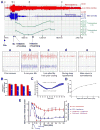Deep hypothermia for the treatment of refractory status epilepticus
- PMID: 26198217
- PMCID: PMC4535418
- DOI: 10.1016/j.yebeh.2015.06.028
Deep hypothermia for the treatment of refractory status epilepticus
Abstract
In a rat model of status epilepticus (SE) induced by lithium and pilocarpine and refractory to midazolam, deep hypothermia (20 °C for 30 min) reduced EEG power over 50-fold, stopped SE within 12 min, and reduced EEG spikes by 87%. Hypothermia deserves further investigation as a treatment of last resort for refractory SE. This article is part of a Special Issue entitled "Status Epilepticus".
Keywords: EEG power; Hypothermia; Status epilepticus.
Published by Elsevier Inc.
Conflict of interest statement
None of the authors has any conflict of interest to disclose.
Figures

Similar articles
-
Effect of mild hypothermia on glutamate receptor expression after status epilepticus.Epilepsy Res. 2012 Aug;101(1-2):56-69. doi: 10.1016/j.eplepsyres.2012.03.001. Epub 2012 Apr 7. Epilepsy Res. 2012. PMID: 22487868
-
Deep hypothermia terminates status epilepticus--an experimental study.Brain Res. 2012 Mar 29;1446:119-26. doi: 10.1016/j.brainres.2012.01.022. Epub 2012 Jan 18. Brain Res. 2012. PMID: 22365745
-
Simultaneous triple therapy for the treatment of status epilepticus.Neurobiol Dis. 2017 Aug;104:41-49. doi: 10.1016/j.nbd.2017.04.019. Epub 2017 Apr 29. Neurobiol Dis. 2017. PMID: 28461248 Free PMC article.
-
Hypothermia as a treatment in status epilepticus: A narrative review.Epilepsy Behav. 2019 Dec;101(Pt B):106298. doi: 10.1016/j.yebeh.2019.04.051. Epub 2019 May 24. Epilepsy Behav. 2019. PMID: 31133509 Review.
-
Therapeutic hypothermia for status epilepticus: A report, historical perspective, and review.Clin Neurol Neurosurg. 2014 Nov;126:103-9. doi: 10.1016/j.clineuro.2014.08.032. Epub 2014 Sep 4. Clin Neurol Neurosurg. 2014. PMID: 25240131 Review.
Cited by
-
Neuroprotective effects of deep hypothermia in refractory status epilepticus.Ann Clin Transl Neurol. 2015 Nov 9;2(12):1105-15. doi: 10.1002/acn3.262. eCollection 2015 Dec. Ann Clin Transl Neurol. 2015. PMID: 26734661 Free PMC article.
-
Ketamine as adjunct to midazolam treatment following soman-induced status epilepticus reduces seizure severity, epileptogenesis, and brain pathology in plasma carboxylesterase knockout mice.Epilepsy Behav. 2020 Oct;111:107229. doi: 10.1016/j.yebeh.2020.107229. Epub 2020 Jun 20. Epilepsy Behav. 2020. PMID: 32575012 Free PMC article.
-
A New Vision for Therapeutic Hypothermia in the Era of Targeted Temperature Management: A Speculative Synthesis.Ther Hypothermia Temp Manag. 2019 Mar;9(1):13-47. doi: 10.1089/ther.2019.0001. Epub 2019 Feb 25. Ther Hypothermia Temp Manag. 2019. PMID: 30802174 Free PMC article. Review.
-
Pharmacotherapy for Pediatric Convulsive Status Epilepticus.CNS Drugs. 2020 Jan;34(1):47-63. doi: 10.1007/s40263-019-00690-8. CNS Drugs. 2020. PMID: 31879852 Free PMC article. Review.
-
Neurosteroid and benzodiazepine combination therapy reduces status epilepticus and long-term effects of whole-body sarin exposure in rats.Epilepsia Open. 2019 Jun 18;4(3):382-396. doi: 10.1002/epi4.12344. eCollection 2019 Sep. Epilepsia Open. 2019. PMID: 31440720 Free PMC article.
References
-
- Mayer SA, Claassen J, Lokin J, Mendelsohn F, Dennis LJ, Fitzsimmons BF. Refractory status epilepticus: frequency, risk factors, and impact on outcome. Arch Neurol. 2002;59:205–10. - PubMed
-
- Treiman DM, Meyers PD, Walton NY, Collins JF, Colling C, Rowan AJ, Handforth A, Faught E, Calabrese VP, Uthman BM, Ramsay RE, Mamdani MB. A comparison of four treatments for generalized convulsive status epilepticus. Veterans Affairs Status Epilepticus Cooperative Study Group. N Engl J Med. 1998;339:792–8. - PubMed
-
- Mazarati AM, Wasterlain CG. N-methyl-D-asparate receptor antagonists abolish the maintenance phase of self-sustaining status epilepticus in rat. Neurosci Lett. 1999;265:187–90. - PubMed
-
- McCullough JN, Zhang N, Reich DL, Juvonen TS, Klein JJ, Spielvogel D, Ergin MA, Griepp RB. Cerebral metabolic suppression during hypothermic circulatory arrest in humans. Ann Thorac Surg. 1999;67:1895–9. discussion 1919–21. - PubMed
Publication types
MeSH terms
Substances
Grants and funding
LinkOut - more resources
Full Text Sources
Other Literature Sources

